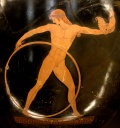Template:Portal:History:Ancient Greece: Difference between revisions
From BoyWiki
No edit summary |
No edit summary |
||
| Line 3: | Line 3: | ||
|align="left" style="font-size:12pt; font-weight:bold; padding:5px"| [[Ancient Greece]] | |align="left" style="font-size:12pt; font-weight:bold; padding:5px"| [[Ancient Greece]] | ||
|- | |- | ||
|[[Image:BERLIN PAINTER -495c Ganymede holding a hoop and a cock (Louvre G175) 1874x1998.jpg|120px|left]] | |[[Image:BERLIN PAINTER -495c Ganymede holding a hoop and a cock (Louvre G175) 1874x1998.jpg|120px|left]] | ||
* [[Ganymede]] is the young, beautiful boy that became one of Zeus' lovers. One source of the myth says that Zeus fell in love with Ganymede when he spotted him herding his flock on Mount Ida near Troy in Phrygia. | * [[Ganymede]] is the young, beautiful boy that became one of Zeus' lovers. One source of the myth says that Zeus fell in love with Ganymede when he spotted him herding his flock on Mount Ida near Troy in Phrygia. | ||
* [[Trochus/Hoop|The hoop]] held symbolic meanings in Ancient Greek myth and culture and was used to represent a boy or youth in general in Greek art. The Greeks referred to the hoop as the trochus or krikoi, and they were probably made of bronze, iron, or copper. | * [[Trochus/Hoop|The hoop]] held symbolic meanings in Ancient Greek myth and culture and was used to represent a boy or youth in general in Greek art. The Greeks referred to the hoop as the trochus or krikoi, and they were probably made of bronze, iron, or copper. | ||
|} | |} | ||
<noinclude> | <noinclude> | ||
[[Category:Templates portal history]] | [[Category:Templates portal history]] | ||
</noinclude> | </noinclude> | ||
Revision as of 15:40, 28 October 2013
| Ancient Greece |

|